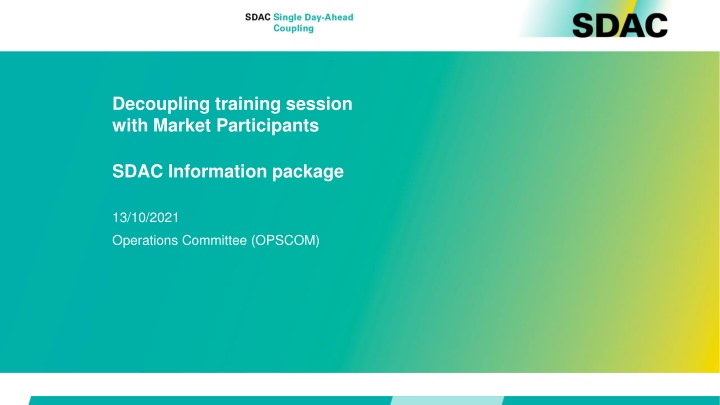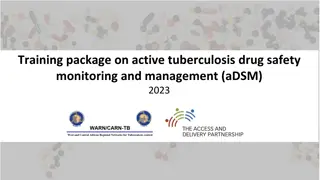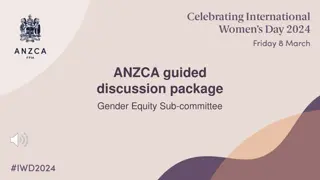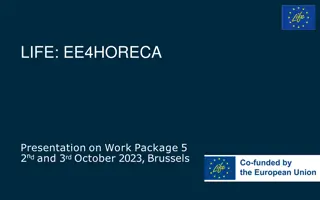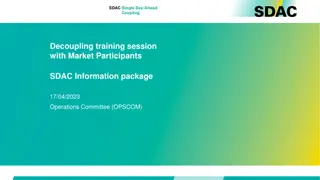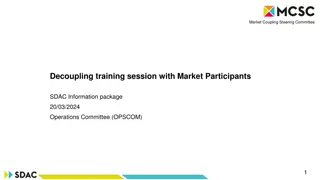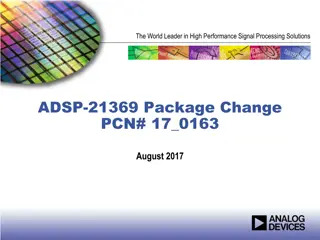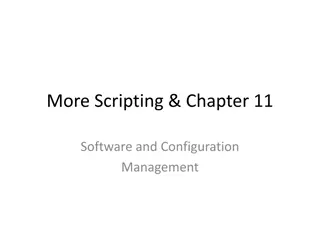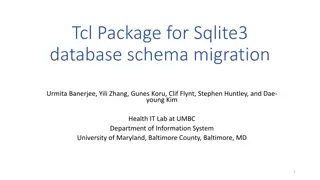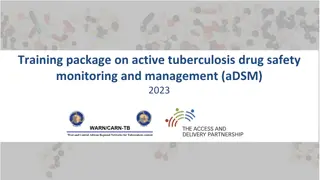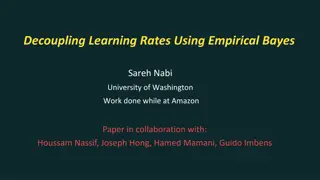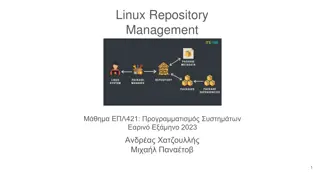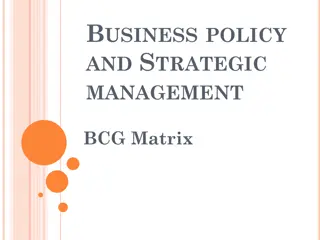Decoupling Training Session with Market Participants: SDAC Information Package
This training session focuses on preparing all operational parties involved in the SDAC market for a potential day-ahead market decoupling incident. Organized to simulate a full decoupling scenario, the session aims to ensure that all participants are well-equipped to handle such situations effectively. The training covers background information, goals, scenario details, operational processes, coordination, evaluation, and fallback solutions. Various incidents and recommendations from past incidents have led to the organization of this training to enhance preparedness and coordination among stakeholders.
Download Presentation

Please find below an Image/Link to download the presentation.
The content on the website is provided AS IS for your information and personal use only. It may not be sold, licensed, or shared on other websites without obtaining consent from the author.If you encounter any issues during the download, it is possible that the publisher has removed the file from their server.
You are allowed to download the files provided on this website for personal or commercial use, subject to the condition that they are used lawfully. All files are the property of their respective owners.
The content on the website is provided AS IS for your information and personal use only. It may not be sold, licensed, or shared on other websites without obtaining consent from the author.
E N D
Presentation Transcript
Decoupling training session with Market Participants SDAC Information package 13/10/2021 Operations Committee (OPSCOM)
Contents 1) Background & Goal 2) Date and timeslot 3) Scenario: Full decoupling of SDAC 4) Operational process and timings 5) Coordination 6) Evaluation and reporting Backup: Fallback Solutions per Interconnector and Bidding Zone 2
1) Background & Goal SDAC Operations Since the go-live of Multi Regional Coupling (MRC, jointly with 4M MC forming SDAC) in 2014, more than 3,100 successful market coupling sessions have been conducted. In the last 4 years, four major incidents have happened that led to a partial decoupling of the SDAC Market. As part of the SDAC evaluation of these incidents, recommendations have been made to perform training sessions involving all operational parties (Transmission System Operators [TSOs], Nominated Electricity Market Operators [NEMOs], Central Clearing Parties, Shadow Auction entities, etc.) including Market Participants. In addition, EFET & EURELECTRIC on behalf of the Market Participants have requested for realistic decoupling training sessions. Goal This training session is organized to give all parties involved the opportunity to validate that they are properly prepared to handle such a day-ahead market decoupling incident in real operations and real-life conditions. 3
2) Date and timeslot Date 13/10/2022 Delivery day 14/10/2022 Timeslot 13:00-18:00 CEST (to have results available from the Fallback auctions) 4
3) Scenario: Full decoupling of SDAC Full vs partial decoupling Because of all the operational mitigating measures in place, a partial decoupling is more likely to occur than a full decoupling. However, in order to make the training session interesting for all participating parties, it has been decided to train for a full decoupling scenario. After the SDAC full decoupling is declared, fallback mechanisms will be activated, where applicable, such as: Shadow/Explicit Auctions, local auctions or regional coupled auctions run by NEMOs. How it will be simulated There are various issues that can lead to a full decoupling of SDAC. Given the very high electricity prices situation in Europe, the SDAC parties have prepared a scenario that reflects these market circumstances and involves a full decoupling. Based on 8 years of DA Market Coupling operations, starting with NWE, subsequently MRC, and now SDAC, we have decided to simulate: A second auction caused by high prices, after closure of the order book That there are technical issues with the central calculation process, meaning that no market coupling results in the second auction will be available at SDAC level. After the second auction is executed, a full decoupling will be triggered The TSOs, NEMOs and JAO will handle everything in line with the procedures. The market participants are expected to respond/act, based on the operational messages from their respective NEMOs and JAO, exactly like in real operations. The complete process chain will be addressed (incl. nomination and matching). Except for Nordic market participants, which are not required to nominate towards eSett following the Nordic-Baltic regional coupling 5
4) Operational process and timings 1/3 as described in the operational procedures Normal process and timings To start with, the TSOs provide cross border interconnector capacities to the coupling system (PMB, meaning PCR Matcher Broker) via NEMOs systems and Market Participants send orders for buying and/or selling through the Local Trading System of their NEMO. At books of each NEMO are closed and submitted to the PMB, which subsequently starts the calculation with the EUPHEMI12:00 (production time), the local order A algorithm. The results of this calculation are subsequently shared and validated by each NEMO before the results can be published towards Market Participants with a preliminary status. After a last round of validations (mainly performed by the TSOs) the results are confirmed as firm and final. Once the results are firm, they are sent to the Shipping Agents who will nominate towards the TSOs. 6
4) Operational process and timings 2/3 Production Testing 09:00 09:15 09:45 10:30 11:00 11:15 11:30 13:00 13:15 13:20 13:30 13:35 13:40 13:45 Start of the Market Coupling Session Latest Time start an IC for issues in the Configuration Synchronization step Deadline to skip the Configuration Synchronization step Target Time for submitting the Network Data in the PMB Latest time to start an IC for missing Network Data (TSOs can join the call) Risk of Partial Decoupling for one or more interconnectors (at regional level) Deadline to declare the Partial Decoupling for an interconnector(at regional level) Pre- Coupling 12:00 12:10 12:25 12:27 12:29 12:35 12:41 12:45 NEMO Order book Gate Closure Time PMB GCT // Reception of all Order Data files in PMBs Start of Calculation Deadline to send the message for Risk of Partial Decoupling End of Calculation Reception of Results in NEMO Local systems + Start of 12 min Confirmation process Second auction triggering Deadline to send the Preliminary Confirmations Generation of GPC Publication of Preliminary Results and sending to the TSOs Start of 12 min Final Confirmation process Message ExC_02: Delay in Market Coupling Results publication=>MPs invited to update Shadow Auction bids* Deadline to send the Final Confirmations Reception of all Final Confirmations in the PMB Generation of GFC Reception of Global Final Confirmation in local PMBs Publication of Final Results Start of Notification Process Deadline to send the message for Risk of Full Decoupling to the TSOs/market Message ExC_03b: Further delay Market Coupling session and risk of Full decoupling =>MPs invited to update Shadow Auction bids* Closure of shadow auction bidding process by JAO Deadline to declare the SDAC Full Decoupling Message ExC_04b: Declaration of Full decoupling Publication of shadow auction process results to relevant parties Local NEMO process for running local auctions or regional coupled auctions, depending on local/regional fallback rules. These auctions will be followed by nominations towards the TSOs. Nordic-Baltic regional coupling results publication *for borders whereShadow Auctions apply 14:00 14:10 14:25 14:27 14:29 14:35 14:41 14:45 Coupling 12:57 12:57 12:57 12:58 13:50 14:57 14:57 14:57 14:58 15:50 14:10 14:20 16:10 16:20 14:25 After 14:30 16:25 after 16:30 16:00 after 17:30 7 Note: Relevant decoupling steps and messages for Market Participants indicated in yellow. Additional regional messages that might apply are not included, because these depend on the regions.
5) Coordination Registration process In case applicable, the respective NEMO(s) and/or JAO will contact the market participants regarding the process to follow. JAO: MPs should register for the test with JAO by sending the email to helpdesk@jao.eu. Deadline to register is 30/09. Environments to connect to JAO: For MPs, the JAO eCAT test plaform. Connectivity establishment JAO: Connectivity will be made available for the JAO eCAT test plaform a few days before the training. 8
6) Evaluation and reporting Evaluation In order to jointly learn and profit as much as possible from this joint training session, it is foreseen to evaluate the session and to address the following questions What went well? What needs more attention? Need for more training sessions? Ideas for the future? Reporting The findings will be captured in a report that will be shared in due time. 9
Backup slide 1: Fallback solution per Interconnector Interconnector Fallback solution SEM interconnectors: NI ROI Nordic-Baltic interconnectors: Nordic internal borders Baltic internal borders NO2-NL (NorNed)* NO2-DE (NordLink)* DK1-DE DK1-NL (COBRA cable) DK2-DE (KonteK) SE4-DE (Baltic Cable) PL-SE4 (SwePol Link) PL-LT (LitPol Link) SE4-LT (NordBalt) EE-FI (EstLink) CORE internal borders: AT DE NL BE BE FR FR DE NL DE BE DE (ALEGrO) (BE-ALBE, DE-ALDE) CZ-AT CZ-DE CZ-DE CZ-PL SK-PL HU-AT CZ-SK SK-HU HU-RO RO-BG DE-PL AT-SI HR-SI HU-HR SWE interconnectors: FR-ES IBWT internal borders: IT FR IT AT IT-SI GR IT BG GR NI-ROI always remains coupled Always remain coupled through Nordic internal coupling Always remain coupled through Nordic internal coupling Shadow Auctions via JAO Shadow Auctions via JAO Shadow Auctions via JAO Shadow Auctions via JAO Shadow Auctions via JAO Capacity goes back to the interconnector owner Capacity goes back to the interconnector owner Capacity goes back to the interconnector owner Always remains coupled through Nordic internal coupling Always remains coupled through Nordic internal coupling Options Depending on the Interconnector/border, the following Fallback solutions may be used: Capacity goes to Intraday; Day Ahead Explicit auction; Shadow auction via JAO; Capacity goes back to the interconnector owner. Regional Coupling (implicit allocation) Shadow Auctions via JAO Shadow Auctions via JAO Shadow Auctions via JAO Shadow Auctions via JAO Shadow Auctions via JAO Shadow Auctions via JAO Shadow Auctions via JAO Shadow Auctions via JAO Shadow Auctions via JAO Shadow Auctions via JAO Shadow Auctions via JAO Shadow Auctions via JAO Shadow Auctions via JAO Shadow Auctions via JAO Shadow Auctions via JAO Shadow Auctions via JAO Shadow Auctions via JAO Shadow Auctions via JAO Shadow Auctions via JAO Shadow Auctions via JAO Shadow Auctions via JAO Shadow Auctions via JAO Shadow Auctions via JAO Shadow Auctions via JAO Shadow Auctions via JAO Shadow Auctions via JAO 10 *In the Fallback Allocation Mechanism, the NO2 bidding zone will be used (i.e. not the NO2A virtual bidding zone)
Backup slide 2: Fallback solution per Bidding Zone Options Depending on the local/regional procedures, the following Fallback solutions may be used: Local auctions run by the relevant NEMOs Regional Coupling (implicit allocation) Bidding Zone Fallback solution Core Bidding Zones (FR, DE/LU, NL, BE, AT, CZ, HU, RO, and SK) SEM (ROI and NI) Nordic Bidding Zones (DK, NO, SE and FI) Local auction run by the relevant NEMOs Local auction run by the relevant NEMO Nordic-Baltic regional coupling between the relevant NEMOs 11
